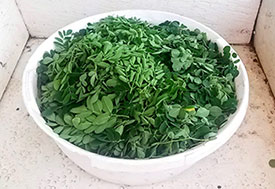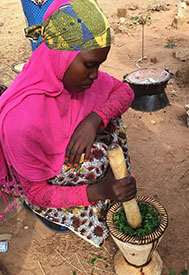Scientist studies the moringa plant’s medicinal, nutritional benefits
January / February 2020 | Volume 19, Number 1

Photo courtesy of Dr. Carrie Waterman
With Fogarty funding, Dr. Carrie Waterman helped Kenyan
farmers improve cultivation and processing of the moringa
plant, known for its medicinal and nutritional properties.
By January W. Payne
The moringa plant has been used for centuries throughout the tropics for medicinal purposes and to improve nutrition, especially in children. A Fogarty-funded researcher is helping to provide the scientific evidence behind the so-called “superfood,” as well as enabling farmers to increase their moringa crop yield and improve the purity of the end product, a powdered diet supplement.
A growing body of evidence suggests that moringa (Moringa oleifera) helps fight inflammation, a known contributor to chronic conditions such as cancer, diabetes and obesity. Dr. Carrie Waterman, a natural products chemist at the University of California, Davis, secured a five-year Fogarty
International Research Scientist Development Award (IRSDA) to explore moringa’s potential. The IRSDA provides support to advanced postdoctoral U.S. research scientists for an intensive, mentored research experience leading to an independent research career focused on global health.
She first became interested in moringa as a Peace Corps volunteer in 2002. “I was growing it, eating it and working with community gardens,” Waterman said. "It's got high nutritional value and also has polyphenols and antioxidants.”

Photo courtesy of Dr. Carrie Waterman
A bowl of harvested moringa.
Waterman - who holds a patent related to the processing of moringa and consults for several moringa companies - used her Fogarty grant to work with farmers in Kenya to determine the most effective cultivation and processing techniques. She compared planting strategies to find the ideal spacing between plants to produce the highest yield. By trying different fertilizers, Waterman showed that ground-up stems and discarded portions on the moringa plant worked as well as cow manure, which might help reduce costs for farmers. She discovered the purity of the product improved if leaves were crushed before drying. She also conducted an economic impact analysis to demonstrate net positive economic returns, encourage more farmers to start growing moringa, and lure more investment in moringa start-ups and community development.
In 2015, Waterman and colleagues published a study that showed
feeding mice moringa extract could delay the onset of diabetes. Mice that ate a high-fat diet supplemented with 5% moringa concentrate had improved glucose tolerance and insulin signaling and didn’t develop fatty liver disease. The moringa-fed mice also gained 18% less weight than the control group. In fact, the supplement nearly eliminated excess weight gain caused by a high-fat diet. The NIH supported this research through its National Center for Complementary and Integrative Health (NCCIH) and its Office of Dietary Supplements (ODS).


Photos courtesy of Dr. Carrie Waterman
Dr. Carrie Waterman used her Fogarty grant to work with farmers in
Kenya to determine the most effective cultivation and processing
techniques.
With the Fogarty grant, Waterman said she was able to study basic moringa-related research questions, as well as the “whole value chain of not just what do these compounds do in a petri dish, but how does this help people on the ground who are facing nutritional and health issues?” Waterman’s recent work in Kenya allowed her to interact with local communities. “I helped them improve their cultivation and processing of it, so that the powder they were making would have more nutrients and more phytochemicals,” she said.
The Fogarty funding has also inspired bidirectional learning. Cultivation, processing and consumption strategies used in Kenya have been shared with farmers in California and vice versa. “We have also built chimney solar dryers to process moringa in both Kenya and California,” said Waterman, who serves as an adviser for research funded by the California Department of Food and Agriculture to assist farmers in Fresno.
Waterman plans to apply for NIH and U.S. Department of Agriculture (USDA) funding to support additional research into how consuming moringa can affect inflammation and chronic disease in humans. “It can both generate income for farmers, as well as provide food security,” she said. “I think moringa can be a smart tool in our toolbox of strategies to approach global health needs in an environmentally and socially conscious way.”
More Information
To view Adobe PDF files,
download current, free accessible plug-ins from Adobe's website.